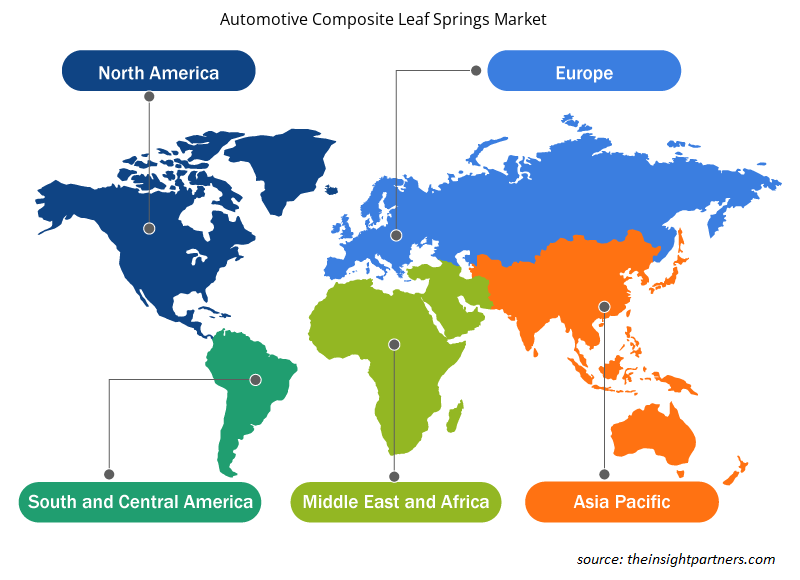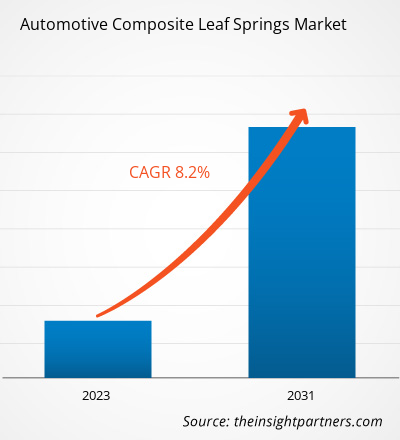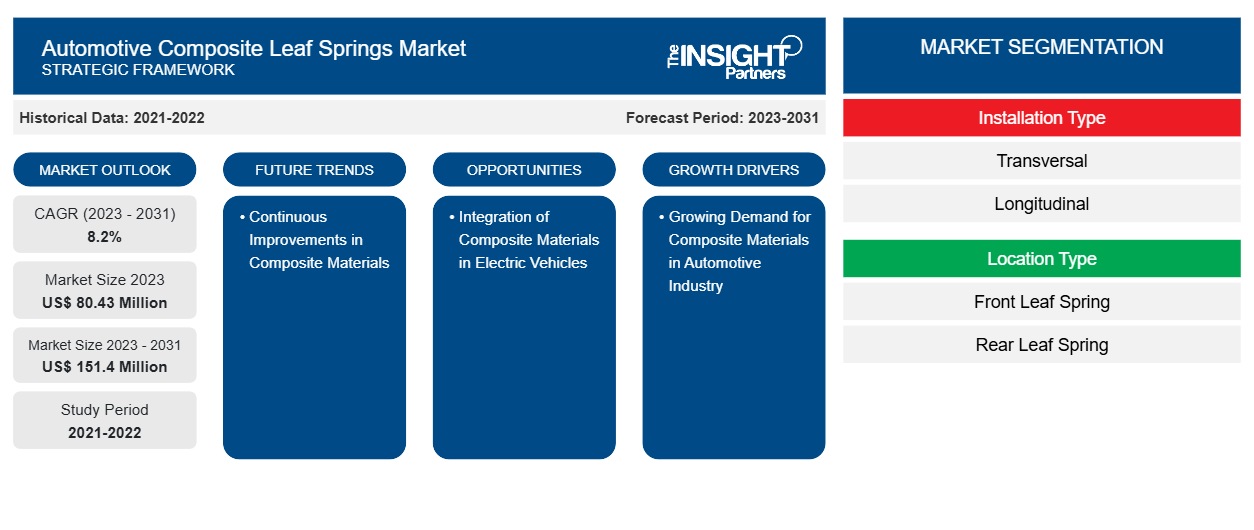Se prevé que el tamaño del mercado de ballestas compuestas para automóviles alcance los 151,4 millones de dólares en 2031, frente a los 80,43 millones de dólares en 2023. Se espera que el mercado registre una CAGR del 8,2 % durante el período 2023-2031. Es probable que la mejora continua de los materiales compuestos siga siendo una tendencia clave en el mercado.
Análisis del mercado de ballestas compuestas para automoción
Se espera que el aumento de la demanda de materiales compuestos en la fabricación de componentes en el sector automotriz impulse el crecimiento del mercado durante el período analizado. Además, se prevé que el aumento de las ventas de vehículos comerciales y de pasajeros, como SUV y camiones ligeros en todo el mundo, impulse el crecimiento del mercado de ballestas compuestas para automóviles durante el período analizado. Además, se espera que la integración y la creciente adopción de materiales compuestos en vehículos eléctricos creen oportunidades para las empresas que operan en el mercado de ballestas compuestas para automóviles entre 2023 y 2031.
Descripción general del mercado de ballestas compuestas para automoción
El ecosistema del mercado de ballestas compuestas para automóviles comprende las siguientes partes interesadas: proveedores de materias primas, fabricantes de ballestas compuestas, OEM y usuarios finales. Los proveedores de materias primas proporcionan el material compuesto, como el compuesto de matriz polimérica, el plástico reforzado con fibra de carbono y el compuesto a base de epoxi, necesario para fabricar las ballestas compuestas para automóviles. La expansión de la industria automotriz ha llevado a varios proveedores de compuestos, como TPI Composites, a colaborar con fabricantes de automóviles y fabricantes de componentes automotrices. Los principales fabricantes de ballestas compuestas para automóviles participan en varios procesos, como el diseño, el ensamblaje y la producción, para transformar la materia prima compuesta en productos terminados. Muhr und Bender KG, KraussMaffei y SGL Carbon son algunos de los principales fabricantes de ballestas compuestas para automóviles. Estas empresas ofrecen ballestas compuestas de alta calidad a OEM, como BMW, Daimler, Volvo y Ford Motor Company, que finalmente instalan el producto durante la producción de vehículos. Los usuarios finales son una gran cantidad de clientes, que van desde compradores de vehículos personales hasta grandes operadores de flotas.
Personalice este informe según sus necesidades
Obtendrá personalización en cualquier informe, sin cargo, incluidas partes de este informe o análisis a nivel de país, paquete de datos de Excel, así como también grandes ofertas y descuentos para empresas emergentes y universidades.
- Obtenga las principales tendencias clave del mercado de este informe.Esta muestra GRATUITA incluirá análisis de datos, desde tendencias del mercado hasta estimaciones y pronósticos.
Impulsores y oportunidades del mercado de ballestas compuestas para automoción
La creciente demanda de materiales compuestos en el sector automotriz favorecerá el mercado
Las ventajas de las ballestas compuestas sobre las ballestas tradicionales están impulsando su adopción en la industria automotriz. Son aproximadamente un 70% más livianas que los resortes de acero, más delgadas y compactas, además de duraderas y resistentes a la carga. Además, permiten una mayor flexibilidad en el diseño y tienen excelentes características de conducción. Las ballestas compuestas también brindan un rendimiento mejorado de los amortiguadores en los vehículos , lo que impulsa su adopción entre los fabricantes de vehículos enfocados en soluciones efectivas de equilibrio de carga. Por ejemplo, Hexcel ha desarrollado ballestas avanzadas basadas en compuestos que ayudan a las camionetas a administrar la carga de manera efectiva. Las nuevas ballestas compuestas que ofrece la empresa ayudan a reducir el peso total de las camionetas en aproximadamente 45 libras por vehículo. Se espera que el creciente enfoque en el uso de materiales compuestos livianos en aplicaciones automotrices impulse el crecimiento del mercado durante el período de pronóstico. Además, se anticipa que un aumento en el enfoque hacia la mejora del rendimiento y la eficiencia de los vehículos al minimizar el peso impulsará el crecimiento del mercado de 2023 a 2031.
Integración de materiales compuestos en vehículos eléctricos
Los vehículos eléctricos representan una tendencia emergente en la industria automotriz, ya que los consumidores y los gobiernos se inclinan fuertemente por el consumo de energía verde en diversas aplicaciones. Los vehículos eléctricos representan una parte menor del mercado general de vehículos, pero están experimentando una tasa de crecimiento más alta que los vehículos basados en combustible. Los fabricantes de vehículos eléctricos están utilizando materiales compuestos para reducir el peso del vehículo como baterías. Esto les ayuda a compensar el peso adicional de las baterías, que se vuelven más voluminosas con el tiempo, para aumentar la autonomía del vehículo. Aura, un nuevo concepto de automóvil deportivo biplaza totalmente eléctrico presentado en septiembre de 2021, se desarrolló utilizando materiales compuestos de fibra natural que ayudan a reducir el peso del vehículo y hacen que los procesos de fabricación sean más sostenibles. Además, un grupo de investigadores de la India publicó un estudio sobre ballestas compuestas para vehículos eléctricos para reducir el ruido, la vibración y la aspereza. En consecuencia, las ballestas compuestas se caracterizan por un peso un 40% menor, una concentración de tensión un 76,39% menor y una deformación un 50% menor que las ballestas escalonadas de acero.
Análisis de segmentación del informe de mercado de ballestas compuestas para automóviles
Los segmentos clave que contribuyeron a la derivación del análisis del mercado de ballestas compuestas para automóviles son el tipo de instalación, el tipo de ubicación, el tipo de proceso y el tipo de vehículo.
- Según el tipo de instalación, el mercado de ballestas compuestas para automóviles se divide en transversal y longitudinal. El segmento transversal tuvo la mayor participación de mercado en 2023.
- Por tipo de ubicación, el mercado está segmentado en ballestas delanteras y ballestas traseras. El segmento de ballestas traseras tuvo la mayor participación del mercado en 2023.
- En términos de tipo de proceso, el mercado se divide en procesos de moldeo por transferencia de resina a alta presión, procesos de laminado de preimpregnados y otros. Los segmentos de moldeo por transferencia de resina a alta presión tuvieron una participación significativa del mercado en 2023.
- Por tipo de vehículo, el mercado se segmenta en turismos, vehículos comerciales ligeros y vehículos medianos y pesados. El segmento de turismos tuvo la mayor participación del mercado en 2023.
Análisis de la cuota de mercado de ballestas compuestas para automoción por geografía
El alcance geográfico del informe de mercado de ballestas compuestas para automóviles se divide principalmente en cinco regiones: América del Norte, Asia Pacífico, Europa, Medio Oriente y África, y América del Sur y Central.
El alcance del informe de mercado de ballestas compuestas para automóviles abarca América del Norte (EE. UU., Canadá y México), Europa (Alemania, Francia, Italia, España, Reino Unido y resto de Europa), Asia Pacífico (China, India, Australia, Japón, Corea del Sur y resto de Asia Pacífico), Oriente Medio y África (Sudáfrica, Arabia Saudita, Emiratos Árabes Unidos y resto de Oriente Medio y África) y América del Sur (Brasil, Argentina y resto de América del Sur). En términos de ingresos, Europa dominó la cuota de mercado de ballestas compuestas para automóviles en 2023. Asia Pacífico fue el segundo mayor contribuyente de ingresos al mercado mundial de ballestas compuestas para automóviles, seguido de América del Norte.
Perspectivas regionales del mercado de ballestas compuestas para automoción
Los analistas de Insight Partners explicaron en detalle las tendencias regionales y los factores que influyen en el mercado de ballestas compuestas para automóviles durante el período de pronóstico. Esta sección también analiza los segmentos y la geografía del mercado de ballestas compuestas para automóviles en América del Norte, Europa, Asia Pacífico, Oriente Medio y África, y América del Sur y Central.

- Obtenga datos regionales específicos para el mercado de ballestas compuestas para automóviles
Alcance del informe de mercado de ballestas compuestas para automoción
| Atributo del informe | Detalles |
|---|---|
| Tamaño del mercado en 2023 | US$ 80,43 millones |
| Tamaño del mercado en 2031 | US$ 151,4 millones |
| CAGR global (2023 - 2031) | 8,2% |
| Datos históricos | 2021-2022 |
| Período de pronóstico | 2023-2031 |
| Segmentos cubiertos | Por tipo de instalación
|
| Regiones y países cubiertos | América del norte
|
| Líderes del mercado y perfiles de empresas clave |
|
Densidad de actores del mercado de ballestas compuestas para automoción: comprensión de su impacto en la dinámica empresarial
El mercado de ballestas compuestas para automóviles está creciendo rápidamente, impulsado por la creciente demanda de los usuarios finales debido a factores como la evolución de las preferencias de los consumidores, los avances tecnológicos y una mayor conciencia de los beneficios del producto. A medida que aumenta la demanda, las empresas amplían sus ofertas, innovan para satisfacer las necesidades de los consumidores y aprovechan las tendencias emergentes, lo que impulsa aún más el crecimiento del mercado.
La densidad de actores del mercado se refiere a la distribución de las empresas o firmas que operan dentro de un mercado o industria en particular. Indica cuántos competidores (actores del mercado) están presentes en un espacio de mercado determinado en relación con su tamaño o valor total de mercado.
Las principales empresas que operan en el mercado de ballestas compuestas para automoción son:
- Sociedad de responsabilidad limitada Hendrickson Holding
- Forma flexible
- KraussMaffei
- Muhr und Bender KG
- Olgun Celik AS
- SGL Carbono SE
Descargo de responsabilidad : Las empresas enumeradas anteriormente no están clasificadas en ningún orden particular.

- Obtenga una descripción general de los principales actores clave del mercado de ballestas compuestas para automóviles
Noticias y desarrollos recientes del mercado de ballestas compuestas para automóviles
El mercado de ballestas compuestas para automóviles se evalúa mediante la recopilación de datos cualitativos y cuantitativos posteriores a la investigación primaria y secundaria, que incluye publicaciones corporativas importantes, datos de asociaciones y bases de datos. A continuación, se enumeran algunos de los desarrollos en el mercado de ballestas compuestas para automóviles:
- Bcomp (empresa de fabricación de materiales ligeros sostenibles) anunció la aplicación de la tecnología de compuestos de fibra natural denominada ampliTex en el nuevo Volvo EX30. (Fuente: Bcomp, comunicado de prensa, junio de 2023)
- Hexion, Inc. se asoció con Rassini. Esta asociación tuvo como objetivo el uso del sistema de resina epoxi EPIKOTE para la aplicación de ballestas compuestas en el nuevo modelo Ford F-150. (Fuente: Hexion, Inc., comunicado de prensa, junio de 2021)
Informe de mercado de ballestas compuestas para automoción: cobertura y resultados
El informe “Tamaño y pronóstico del mercado de ballestas compuestas para automóviles (2021-2031)” proporciona un análisis detallado del mercado que cubre las siguientes áreas:
- Tamaño del mercado de ballestas compuestas para automoción y pronóstico a nivel global, regional y nacional para todos los segmentos clave del mercado cubiertos bajo el alcance
- Tendencias del mercado de ballestas compuestas para automóviles, así como dinámica del mercado, como impulsores, restricciones y oportunidades clave
- Análisis PEST y FODA detallados
- Análisis del mercado de ballestas compuestas para automóviles que abarca las tendencias clave del mercado, el marco global y regional, los principales actores, las regulaciones y los desarrollos recientes del mercado
- Análisis del panorama de la industria y de la competencia que abarca la concentración del mercado, el análisis de mapas de calor, los actores destacados y los desarrollos recientes del mercado de ballestas compuestas para automóviles
- Perfiles detallados de empresas
- Análisis histórico (2 años), año base, pronóstico (7 años) con CAGR
- Análisis PEST y FODA
- Tamaño del mercado, valor/volumen: global, regional y nacional
- Industria y panorama competitivo
- Conjunto de datos de Excel
Informes recientes
Informes relacionados
Testimonios
Razón para comprar
- Toma de decisiones informada
- Comprensión de la dinámica del mercado
- Análisis competitivo
- Información sobre clientes
- Pronósticos del mercado
- Mitigación de riesgos
- Planificación estratégica
- Justificación de la inversión
- Identificación de mercados emergentes
- Mejora de las estrategias de marketing
- Impulso de la eficiencia operativa
- Alineación con las tendencias regulatorias





















 Obtenga una muestra gratuita para - Mercado de ballestas compuestas para automoción
Obtenga una muestra gratuita para - Mercado de ballestas compuestas para automoción